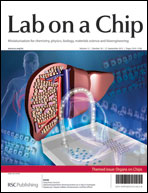Microfluidic heart on a chip for higher throughput pharmacological studies†
Abstract
We present the design of a higher throughput “heart on a chip” which utilizes a semi-automated fabrication technique to process sub millimeter sized thin film cantilevers of soft elastomers. Anisotropic cardiac microtissues which recapitulate the laminar architecture of the heart ventricle are engineered on these cantilevers. Deflection of these cantilevers, termed Muscular Thin Films (MTFs), during muscle contraction allows calculation of diastolic and systolic stresses generated by the engineered tissues. We also present the design of a reusable one channel fluidic microdevice completely built out of autoclavable materials which incorporates various features required for an optical cardiac contractility assay:

- This article is part of the themed collection: Organs on a Chip 2013

 Please wait while we load your content...
Please wait while we load your content...